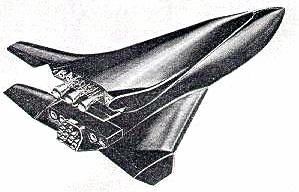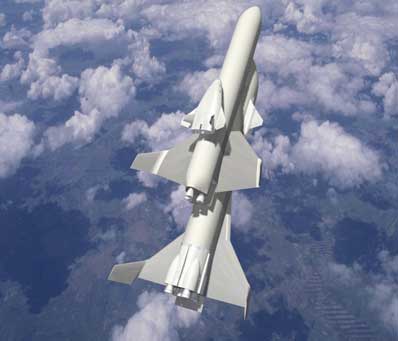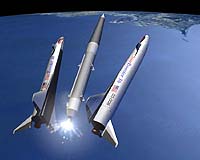New Mars Forums
You are not logged in.
- Topics: Active | Unanswered
Announcement
#1 2021-06-24 11:56:39
SSME based SSTO’s.
In actuality practical SSTO’s have been feasible since the 70’s, with the development of the high performance Space Shuttle Main Engine(SSME). Here’s a SSTO that modifies the Delta IV first stage using carbon fiber tanks and two SSME’s to replace the RS-68 engine used on the Delta IV.
SSME based SSTO’s.
https://exoscientist.blogspot.com/2021/ … sstos.html
Robert Clark
Old Space rule of acquisition (with a nod to Star Trek - the Next Generation):
“Anything worth doing is worth doing for a billion dollars.”
Offline
Like button can go here
#2 2021-06-24 18:36:22
- kbd512
- Administrator
- Registered: 2015-01-02
- Posts: 8,255
Re: SSME based SSTO’s.
RGClark,
In the same article you posted about, the theoretical RS-25 based SSTO would get 8t to LEO, whereas a TSTO with a RS-25 and a RL-10 would deliver 21t to LEO. That's why nobody is using SSTOs. We can nearly triple the payload by using a TSTO. The booster represents most of the cost and dry mass of the rocket, so creating a combined upper and lower stage reusable launch vehicle is much more challenging to design while staying within acceptable mass constraints after a reusable heat shield is applied to the entire vehicle. If both stages need to be reusable, then the TSTO can have very little heat shielding applied to the booster, or none if it's fabricated from stainless steel, and then the upper stage is the only portion that requires a heat shield. If LH2 had the density of RP1, or far less of it was required by using external microwave heating to raise the Isp to around 1,000s or so, then a fully reusable SSTO becomes a lot more practical in actual operation. Anyway, SSTO only makes sense from the perspective of full reusability with a small enough surface area to compare favorably TSTO in terms of total vehicle mass and therefore cost.
Offline
Like button can go here
#3 2021-06-24 18:45:39
- SpaceNut
- Administrator
- From: New Hampshire
- Registered: 2004-07-22
- Posts: 29,483
Re: SSME based SSTO’s.
The moment you add in reusability to first stage you get less payload to orbit as its gets eaten up by the fuel mass shift which is a bit over 25% of the firsts stages full tank which is where the Falcon 9 is....
Offline
Like button can go here
#4 2021-06-24 20:27:42
- RobertDyck
- Moderator
- From: Winnipeg, Canada
- Registered: 2002-08-20
- Posts: 8,229
- Website
Re: SSME based SSTO’s.
How do wings compare to propellant for first stage return?
Shuttle LS A (1969)
Offline
Like button can go here
#5 2021-06-25 20:22:25
- SpaceNut
- Administrator
- From: New Hampshire
- Registered: 2004-07-22
- Posts: 29,483
Re: SSME based SSTO’s.
I am reminded of the flyback booster system from the space launch initiative of the early 2000 when shuttle was to be no more but it was sort of a franchinstein https://wikimili.com/en/Space_Launch_Initiative
or this version
with another looking more like 2 planes with a rocket between them
Offline
Like button can go here
#6 2021-06-28 12:58:33
Re: SSME based SSTO’s.
RGClark,
In the same article you posted about, the theoretical RS-25 based SSTO would get 8t to LEO, whereas a TSTO with a RS-25 and a RL-10 would deliver 21t to LEO. That's why nobody is using SSTOs. We can nearly triple the payload by using a TSTO. The booster represents most of the cost and dry mass of the rocket, so creating a combined upper and lower stage reusable launch vehicle is much more challenging to design while staying within acceptable mass constraints after a reusable heat shield is applied to the entire vehicle. If both stages need to be reusable, then the TSTO can have very little heat shielding applied to the booster, or none if it's fabricated from stainless steel, and then the upper stage is the only portion that requires a heat shield. If LH2 had the density of RP1, or far less of it was required by using external microwave heating to raise the Isp to around 1,000s or so, then a fully reusable SSTO becomes a lot more practical in actual operation. Anyway, SSTO only makes sense from the perspective of full reusability with a small enough surface area to compare favorably TSTO in terms of total vehicle mass and therefore cost.
Thanks for the response. Going the high performance engine and lightweight tanks route can double the payload. Note that SpaceX spent quite a bit of time and money to double the F9 payload with the F9 Full Thrust. This would be an alternative way of accomplishing the same thing. Quite key to remember is that a high performance engine can be accomplished by using an existing midlevel performance engine such as the RS-68 on the Delta IV or the Merlin on the Falcon 9 by adding an altitude compensation nozzles. You don't need an expensive engine such as the SSME.
Here's one simple way, low cost way of getting altitude compensation: flexible, extensible, nozzle attachments:
So launch companies can double the payloads of their TSTO by taking this approach. BUT additionally it would also allow their first stage alone to have significant payload to LEO. Note most payloads don't need the full launchers payload capacity to space. Then with the SSTO you could launch the smaller payloads more cheaply without needing the upper stage at all.
Robert Clark
Last edited by RGClark (2021-06-28 12:59:18)
Old Space rule of acquisition (with a nod to Star Trek - the Next Generation):
“Anything worth doing is worth doing for a billion dollars.”
Offline
Like button can go here
#7 2021-06-28 18:06:44
- kbd512
- Administrator
- Registered: 2015-01-02
- Posts: 8,255
Re: SSME based SSTO’s.
RGClark,
If the vehicle was expendable, then payload could potentially be doubled. In practice, the heat shield mass for a reusable vehicle seems to gobble up the rest of that potentially increased payload performance. That leaves us with a high-cost, low-payload-performance vehicle requiring extensive refurbishment or repair prior to requalification for subsequent flights.
RS-68 weighs as much as 4 Raptors, so you can have about 3 times the thrust at liftoff for equivalent weight. An additional 15 seconds of Isp can't make up for 3 times as much thrust for equivalent weight, in order to get the vehicle moving downrange fast enough for a smaller / higher Isp state to work its magic.
Why not get the best of both worlds with a LOX/LCH4 booster stage and a much smaller but reusable LOX/LH2 upper stage (with a much smaller and cheaper heat shield)?
For example, a Raptor-powered booster with a RS-25 powered upper stage could provide enough payload performance to account for the upper stage's heat shield mass and the wings necessary for it to glide to a landing, while the much larger booster could be recovered via the SpaceX method.
SpaceX could use something between a behemoth rocket more powerful than a Saturn V and the Falcon 9 / Falcon Heavy series, possibly as a more economical replacement for both Falcon 9 and Falcon Heavy. A 9 Raptor booster with 1 RS-25 upper stage would be powerful enough to deliver a science mission anywhere within the solar system, especially if the new RS-25 variants will be expendable.
Offline
Like button can go here
#8 2021-06-28 18:35:00
- SpaceNut
- Administrator
- From: New Hampshire
- Registered: 2004-07-22
- Posts: 29,483
Re: SSME based SSTO’s.
The rehashed RS-25 was a reuseable engine but the improved unit is more towards being a throwaway now that its part of the sls first stage.
Nasa did look at the 68 of Boeing for a use but the congress steered them back to shuttle components. They were looking to man rate the engine for use in constellation.
Offline
Like button can go here
#9 2021-06-29 11:06:03
Re: SSME based SSTO’s.
Using high performance engines or adding altitude compensation plus lightweight tanks can triple the payload of the current Delta IV Heavy to ~70 tons to LEO:
SSME based SSTO’s. UPDATED, 6/28/2021 - Extension to the Delta IV Heavy.
https://exoscientist.blogspot.com/2021/ … sstos.html
Note this brings it into the payload range of the Falcon Heavy. Missions such as Robert Zubrins’s Moon Direct that require 3 launches of the Falcon Heavy for the cargo portions of the mission could be done by this upgraded Delta IV Heavy.
Also, I discuss in the update that the ~20 ton payload to LEO of the upgraded Delta IV means it could get the same payload as a partially reusable Falcon 9, so could compete with SpaceX for the lucrative commercial satellite market.
Robert Clark
Old Space rule of acquisition (with a nod to Star Trek - the Next Generation):
“Anything worth doing is worth doing for a billion dollars.”
Offline
Like button can go here
#10 2021-06-30 13:34:22
- kbd512
- Administrator
- Registered: 2015-01-02
- Posts: 8,255
Re: SSME based SSTO’s.
RGClark,
Although Skylon looks like the most promising SSTO concept, if it used a booster, it would still have greatly increased payload to orbit. Assuming materials science allows for rapidly reusable engines and heat shields, we're still left with the energy cost of the propellants and the energy cost of the materials used to construct reusable orbital vehicles. We can economize on both by accepting that the physics of space flight using chemical rocket engine technology dictates the use of two stages to achieve orbital velocity. In a best case scenario, both stages are rapidly reusable and do not require bleeding edge performance, so that the engine / vehicle / heat shield design problems are drastically simplified. From there, we can optimize the size of the two stages and the propellant combinations and consumption rates to maximize payload performance for a given propellant burn.
Offline
Like button can go here
#11 2025-07-05 06:56:55
- tahanson43206
- Moderator
- Registered: 2018-04-27
- Posts: 21,879
Re: SSME based SSTO’s.
For all...
GW's work posted in the exrocketman.blogspot.com site is now available by a single click.
https://exrocketman.blogspot.com/search?q=ssto
The paper is detailed, with plenty of graphs to illustrate the text.
I am guessing here, but it is possible that anyone offering an opinion without reading the paper is indeed likely to be missing something important.
(th)
Offline
Like button can go here


